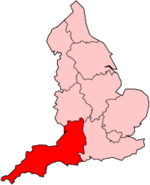Wooston Castle
Devon building and structure stubsHill forts in DevonMoretonhampsteadUnited Kingdom archaeology stubs

Wooston Castle is an Iron Age Hill fort situated on the edge of a hill overlooking the Teign Valley in Devon some 200 metres above sea level, only 3 km south and east of Prestonbury Castle and 5 km east of Cranbrook Castle.
Excerpt from the Wikipedia article Wooston Castle (License: CC BY-SA 3.0, Authors, Images).Wooston Castle
Scotley Bridge, Teignbridge Dunsford
Geographical coordinates (GPS) Address External links Nearby Places Show on map
Geographical coordinates (GPS)
| Latitude | Longitude |
|---|---|
| N 50.6936 ° | E -3.75 ° |
Address
Wooston Castle (Fort)
Scotley Bridge
EX6 6QB Teignbridge, Dunsford
England, United Kingdom
Open on Google Maps










